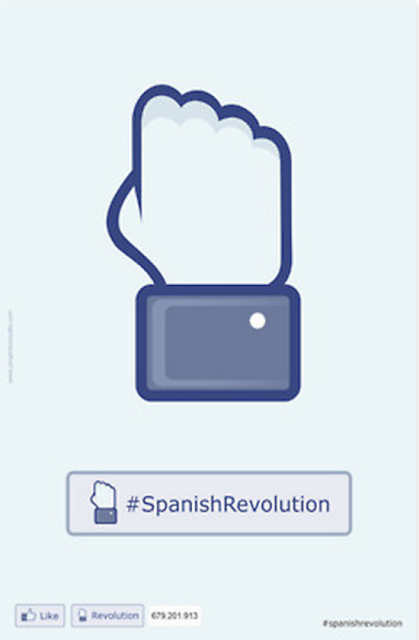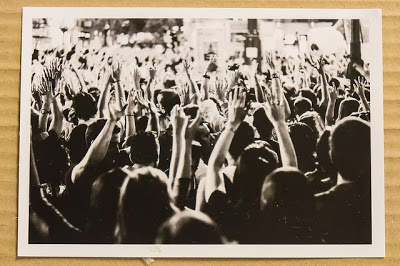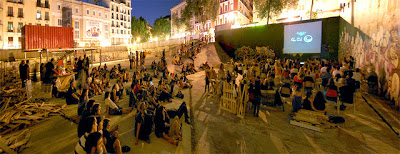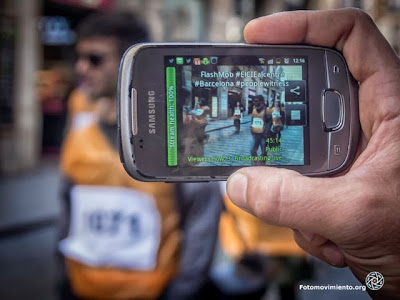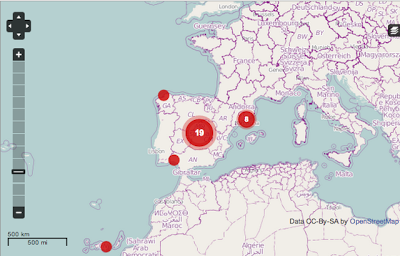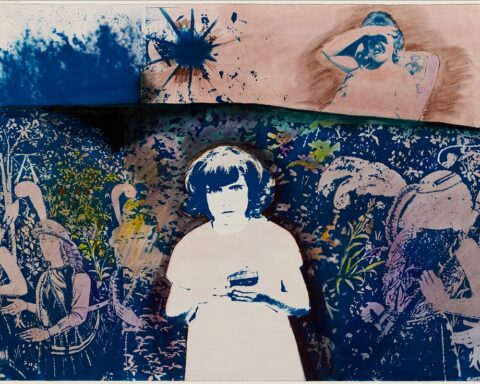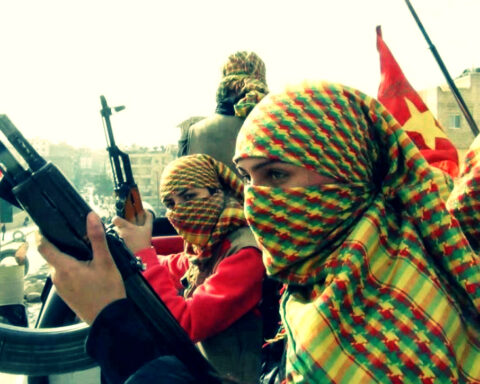Dear comrade, for sure there are a lot of projects In this article that Void Network disagree with them or we could critisize them as naive, non antagonistic, alternative or passive. But we have to agree that there is a lot of inspiration, a lot of creative effort, a lot of fantasy and many many good intentions in all these projects that this article includes. It is the work of all of us to bring these projects further and further
to understand their limitations and use them as better as possible as 21st century beneficial tools for radical social transformation
VOID NETWORK
Translated by Stacco Troncoso, edited by Jane Loes Lipton – Guerrilla Translation!
Originally published in two parts at 20minutos.es. Part 1. Part 2
“The old protests, so dull and single-minded, have passed into obsolescence, and given rise to infinite possibility. We’ve rethought the concepts of action, protest, relationship, the public, the common…”
In the collective text, This is Not a Demostration, we find a hidden corner of thoughtfulness completely ignored by mass media. This is Not a Demonstration isn’t an exercise in nostalgia. There’s no sense of longing for that Vibrant Mass that Occupied the Squares which formed that unpredictable collective body, the tangle of relationships some call “The 15-M Movement”.
This is Not a Demonstration has taken all-inclusive stock of actions, processes and projects which simply can’t be done justice by the old lexicon of protest. This is not a demonstration, we said: “And our imagination has totally overflowed the space of what’s possible, even as we build new worlds upon the carcass of the old”. This is not a demonstration. This is not a sum total. This is more than a rattling-off of victories. This is more than an echo of “we’re going slow, because we’re going far”.
Some of the media is too quick to bury “what’s left of 15M”. After the second anniversary protest of May 12th, which took place all across Spain, some will rush to hammer the final nail in 15M’s coffin. After the headcount, they’ll pick the photo with the sparsest crowd. They’ll even go so far as to manipulate some images, like any dictatorship would.
Alone in their cave, they’ll toast the funeral, reflected in the tarnished mirror of old-world media. They won’t see the details, the process, the steady drip. They will not take note. They will not listen. They will not read this text.
Surely, 15M is too complicated to be easily categorized, explained, translated. Besides, the eye sees what it’s used to seeing, as Amador Fernández-Savater reminds us in his highly recommended Seeing the Invisible: on Unicorns and the 15-M Movement. But it might just be possible to catch a glimpse of its transformative power by describing the little things, the modest dreams, the collective projects, invisible to many. There´s no need for that utopia of May 68, that ridiculous “Beneath the paving stones, the beach” which never materialised. There´s no need for it because 15M has already built its own: dozens, hundreds, thousands of networked micro-utopias. 15M has no use for a utopian model because it already has one, hundreds, thousands, of working prototypes. Micro-utopian prototypes, connected amongst themselves and (almost) in real time.
Keyword: Prototype. “An early sample or model built to test a concept or process or to act as a thing to be replicated or learned from”. Digital culture, copyleft processes and the hacker ethic, so pervasive in the leadup to 15M, all imbued their spirit in this new revolution of the connected crowd. The working prototype, within this new, open, process-based world, replaces any fixed model. And 15M is still churning out prototypes. It has built them collectively, as a network and in an open way.
The initial Acampada Sol (encampment at Madrid’s Puerta del Sol square) wasn’t made up of groups protesting the collapse of the system. Within the encampments were prototypes for the new world. And the devil was in the details: its day-care centers, its open libraries, its food gardens, its video streaming, its analogue and digital mechanisms for proposing change. 15M – whether seen as a signal, a movement, a state of being or a set of human interactions – has built its prototypes, and they’re many: judicial, urban, cultural, economical, technological, communicative, political, affective.
The true power of 15M doesn’t lie in its (necessarily) reactionary collective defense of the welfare state. Its real, and massive, hidden strength is in its creative, innovative, proposal-oriented nature. Given our willfully blind politicians and media, increasing the visibility of these real, shareable, living prototypes is crucial, now more than ever. But it’s not a list we need, it´s more like an act of poetic justice. A subjective inventory, giving shape to something so big we don’t yet have a name for it.
As we’ve been saying for some time, being happy is our best revenge.
PROTOTYPE 1:
THE METHOD MICRO-UTOPIA
Image: Ondas de Ruído. Creative Commons Share Alike 2.0
The encampments of 2011, specifically their restoration of community assemblies, took the political old guard by surprise. Here were non-hierarchical, open assemblies that anyone could take part in. For the first time in decades, we saw political assemblies held in public spaces. Assemblies that turned into method, human hardware for uniting urban citizens. The need for consensus arose from a spirit of dialogue and coexistence, born in reaction to the visceral antagonism of the old political class: we won’t go until we reach an agreement. Following the erosion of the mechanisms of consensus during the encampments, the strategy of geographical and thematic diaspora came into being. #TomaLosBarrios (#TakeTheHoods). #TomaLaPlaya (#TakeTheBeach). #TomaLoqueQuieras (#TakeWhateverYouWant. Join with others. Open it up. And, from the hardships of coexistence, the slow nature of consensus, from decentralization, the workings of autonomy emerged..
In free software jargon, “fork” describes a peaceful deviation within a common project. The term was quickly adopted in 15M citizen politics. The newly formed Comité Disperso (Scatttered Committee) sums up 15M’s fresh ways of dealing with an assortment of processes. “You can be there without always being there. You can be, without being the same. You can participate without needing to tie yourself to anything or giving up your autonomy. Acting from mutual respect, scattered organization allows varying degrees of collaboration amongst people and collectives, according to their own wishes, goals and abilities at any given moment”. It isn’t surprising then that Partido X, Partido del Futuro, which forked out from 15M, defines itself as “a method”.
PROTOTYPE 2:
THE URBAN MICRO-UTOPIA
Image: Campo de Cebada. Creative Commons Share Alike 2.0
The encampments led to a double mutation of urban space. First: the shift from public space into common space. Public squares, beset by excessive prohibitions and the privatization of their usage, were reborn as the urban commons. A leaderless, non-hierarchical citizen network organized this urban space “peer-to-peer”, consisting of interconnected public squares.
Second mutation: hybrid space. These weren’t squares made of paving stones. These squares were of bits and atoms. Analogue and digital life were intimately intertwined, inseparable. During the encampment at Sol, theTwittómetro connected networks and public squares, virtual and physical spaces. The #AbreTuWIFI, (#OpenYourWifi) campaign, which encourages people to open their home WI-FI access during protests to allow easy communication, nurtured this new hybrid urban space. Another good example is the #Voces25S map, created to protect mass groups from police violence. You only had to tweet from your GPS-activated mobile phone to lay out the “digital rug” over the physical city-space.
The first of the two mutations described above is building a network of former public spaces, now transformed into self-organising, self-governed places bristling with activity, like Madrid’s Campo de Cebada, recent winner of Ars Electronica’s prestigious Golden Nica Award in the Digital Communities category. These spaces are often supported in part by stale, dried up public institutions desperate for new ideas. The second mutation is branching out through Convoca!, a mobile app that allows you to check in at gatherings, protests, events or encampments. Both mutations coalesce in a melting pot of networked spaces, connecting peers locally and globally, beyond institutions or boundaries, on the fringes of commercial logic.
READ MORE NEW PROTOTYPES OF STRUGGLE HERE:
PROTOTYPE 3:
THE COMMUNICATION
MICRO-UTOPIA
photo: http://fotomovimiento.org/
Very few countries have put into practice sociologist Manuel Castells’ concept of “mass self-communication” at the same level as Spain. Under the nose of a mass media trapped in its clichés and corporate compromises, 15M created an historically unparalleled system of mass communication. It introduced transparency as a method: video streaming of assemblies, open minutes and documents for every meeting, a transparency at once action and communication. From the get-go, 15M produced better live-streamed media of protests than anyone else. TV grew increasingly irrelevant when compared to on-the-ground video streaming as exemplified by People Witness or Toma La Tele. The revolution had finally been televised, contrary to Gil Scott Heron’s prediction (The Revolution will not be televised). What’s more, some written media, after seeing the global impact of SolTV and citizen-streaming, felt the need to catch up by aping the method and providing live video too.
A good number of photopress agencies lost some lustre to the explosive, poetic material showcased by FotoMovimiento. Meanwhile Audiovisol, Agora SolRadio or the printed-paper Periódico 15M have set the new standard in intelligent mass self-communication.
Some new media such as ElDiario.es, La Marea, Reset Project, Revista Números Rojos or Café amb Llet were born steeped in the micro-utopic communicative spirit of 15M. And if that wasn’t enough, let’s not forget 15M’s role as a global Twitter-trending-topic machine, planned on collective pads such as this one, and which are already being studied in the communication programs of universities worldwide.
PROTOTYPE 4:
MICRO-UTOPIA IN FEMININE
Vídeo: presenting the Zorras Mutantes
(Mutant “Ho”s) in Sol General Assembly, 3rd of May 2012.
Spanish, being a gender-based language, was hacked to be gender-flexible (from nosotros to nosotras) early on in the encampments. We started seeing men speaking very naturally in feminine/gender inclusive forms of speech, a hugely significant detail. It’s a symbolic mutation, a step onwards from competition to collaboration. This is the tip of the iceberg of a new worldwide paradigm. I’m not referring to it as a Feminine Micro-utopia, because this shift runs much deeper than that. At the very least, we’re witnessing a remix of classical feminism, which, at times, has constructed the same kinds of antagonistic and categorical walls as “machismo”. 15M is creating a grounded, intuitive outgrowth of Donna Haraway’s utopian cyberfeminism.
The existence of assemblies such TransMaricaBollo (composed of LGBT collectives in Madrid) is another example of the micro-utopian aggregate, inclusive and genre-transcendent, that 15M as a movement is striving for. While not being central to the movement, the Zorras Mutantes assembly, which plays with the queer movement, polyamory and the jargon of “cyborg-feminism”, is another spark within this #PostFeminist, #PostPatriarcal micro-utopia. Here’s an extract from their manifesto: “We’re animal-human-machine-software hacking the limits of established norms (…) We’re on strike, striking against species and gender: we renounce our binary gender and human categorizations, arbitrary classifications of an imperialist tradition (…) We abhor subject-object dualism, possessive individualism and the right to own property, and we declare ourselves as metabodies.”.
PROTOTYPE 5:
THE COLLECTIVE CULTURE
MICRO-UTOPIA
Copyleft culture – conceived as a reaction to copyright – directlly influenced 15M. Copyleft idealism and its legitimization of copying and recycling content was at an all-time high in the months leading up to 15M, due to the threat of the antipiracy Sinde Law. These intuitive, collective and unplanned tenets formed the backbone of the #GlobalRevolution. Public squares acquired copyleft traits, becoming ctrl+v spaces constantly mirrored in their digital doppelgangers through texts on how to camp, how to videotape in a constant and unprecedented barrage of infectious creativity.
Born in the wake of 15M’s explosive appearance, Fundación Robo (or, “Steal this Foundation”), diluted the concept of individual authorship, churning out songs authored by the collective identity of Robo (Steal). Freely downloadable songs, under open licenses. Meanwhile, Asalto (Assault), Robo’s literary counterpart, was born soon afterwards, with its collective literature and poetic snippets remixed into intense “Collective Assaults”. And Plazas Invisibles (Invisible Squares), as written by Italo Calvino with the 99%. And VocesConFutura, visual shout-outs by inspired graphic creators camped within 15M pixellated environs. And Bookcamping.cc created to answer the innocent question, “what book would you take to the square?” With its book-filled shelves, its playlist of titles, its guided visits, Bookcamping.cc stands as a prime example of the new web-created and commons-oriented culture. But, it’s possible that 15M.cc, – a transmedia project composed of a book, a documentary and the 15Mpedia – may well be the best across-the-board representation of the collective, open and collaborative spirit of 15M’s cultural micro-utopia.
Remixing – A copies B, B recreates A’s original work – turns flaws into virtues. Remixing becomes an homage, a co-creation – and, why not, a battle cry. What could be better than #cutandpaste a fragment from “Asalto nº 4, Lorca remix” in support of Marea Verde and its defense of public education. “Green that I love you Green. Green wind. Green branches. Education needs your hand, to help avenge it, to expel those seeking the failure of the masses”.
PROTOTYPE 6:
PARTICIPATORY
MICRO-UTOPIA
The assemblies, celebrated in public squares, marked a previously unheard of politicization of public space. Even taking into account that their consensus building mechanism didn’t end up directly influencing the democratic process, the creation of new spaces for political dialogue soon made the old institutions look dated. The project/process Parlamento a la Calle (Take Parliament to the Streets) for example, is a true master stroke against a static democracy that only allows for dialogue within the chambers of parliament. Besides, public-square assembly did manage to consolidate certain specific mechanisms.
This yearning for participation is the essence of Propongo (I Propose), a tool and platform for the collection and implementation of political ideas by a collective voting system. Propongo inspired the Rio Grande do Sul’s (Brazi) Digital Cabinet. Meanwhile, Asamblea Virtual (Virtual Assembly), a participatory online system where proposals are drawn, debated and voted on, has become an invaluable laboratory for techno-political participatory systems. Similar initiatives, such as Ahora tu decides (Now You Decide), a platform for non-state-mediated digital referendum, the urnas indignadas, physical voting booths placed on the street last November to vote on the proposal against foreclosures, or ballot information tables set up by public health defenders, Marea Blanca, make an important symbolic statement capable of forcing change in the system’s participatory mechanisms. Finally, Graba tu pleno (Record your Plenary Session) which encourages transparency by inciting citizens to video every single convention of assemblies, could also be considered another 15M prototype.
Demo4Punto0 (Democracy 4.0) is perhaps the most innovative initiative of them all. A hybrid participatory strategy and mechanism, it would allow any citizen to digitally vote on any parliamentary proposal or law. Based on each political party’s ratio of seats in Parliament, the mechanism proportionally discounts a seat for every 150.000 that participate in a vote. These citizen votes represent a proportional part of a congressman’s constituency. It’s no coincidence that the regional government of Andalucia (in the south of Spain), has commissioned the groundbreaking Andalusian Digital Democracy Report from the founders of Demo4Punto0.
PROTOTYPE 7:
FUN-TIVISM
MICRO-UTOPIA
Non-violence has always been an inspiration to 15M. The Movement resurrected peaceful resistance and adapted it to the Internet age. Repudiating weapons and classic urban guerrilla tactics, 15M made protest creative, constructive and, unmistakably, fun. Networked emotions and viral actions that amplified and altered their own effects. Culture Jamming, the remixing of logos and commercial symbols as exemplified by Adbusters, morphed into something else in Spain. 15M’s culture jammers became virtual DJs, spinning memes and emotions. We saw how Flo6x8, a flash mob collective, was able to flamenco their way into a bank. We saw a crowd throwing a party in a Bankia branch, to promote its #CierraBankia (#ShutDownBankia) campaign. Bankia was Spain´s own big-bank-bailout debacle, going from public bank to private entity, subsequently bankrupting itself and then controversially being rescued with public funds, concurrent with the imposition of austerity measures. We were delighted by the parodical Ballot Box ATM: if it´s the banks that really govern us after all, why not just vote directly while at the bank?
Political Jiu-jitsu, or defeating an enemy by turning its strength against itself, is the tactic used by the Metro de Lujo (Subway DeLuxe) campaign. Elegantly attired individuals protested the Madrid subway’s inscrutable price hikes by dressing up and toasting champagne to welcome the new “aristocratic” pricing. Or, how about the ultimate fetid vengeance, exemplified by the #TubasuraalBanco (#TakeYourGarbageToTheBank) campaign – which, ultimately, made it as far as Portugal (#OLixoAosBancos). Another hilarious example is the #ManiFicció/#ManiFantasma (#FicticiousProtest/#GhostProtest), a fake protest announced as a total urban guerrilla outing, which managed to ridicule and embarrass Catalonia’s riot police (Mossos D’Esquadra), when they arrived to meet the dangerous enemy to find… no one!
15M has creatively and humorously reinterpreted the tenets of Saul Alinsky classic “Rules for Radicals”, or The Guerrilla Communications Handbook. amongst other direct action classics. Additionally, it has birthed a particularly active army of Twitter troll activists. Profiles such as @barbijaputa or the @ikastrolla collective are prime examples.
PROTOTYPE 8:
RESILIENCE
MICRO-UTOPIA
Faced with the unjustified rising cost of public transport, classic resistance-based activism would respond with barricades, protests and setting things on fire. On the other hand, resilience-based activism uses adaptation, micro-attacks, and hacking, expressed through cracks and loopholes in the legal system. “Translegal”, rather than illegal. IGetOn YouGetMeoOn… non-payment tactics for public transport. If you get fined, there’s a co-op that will handle the cost of the fine. It works out cheaper to make a monthly contribution to the MeMetro (IGetOn) co-op than paying the regular monthly pass. Adapted from an identical initiative in Greece, the YoNoPago movement fights against the rising cost of highway tolls and public transport, another sign of resilience. When the VAT was raised 21% for Spanish freelancers, a new “bacterial” web-based network called #HuelgaAutónomos (Freelance Strike) sprung up to deal with the problem by paying individual taxes collectively, or by refusing to declare income on certain months (Freelancers in Spain are required to pay a disproportionately high fixed monthly fee to able to work legally).
PROTOTYPE 9:
THE NETWORKED
POST-SYNDICATE
MICRO-UTOPÍA
Imagen: Marea Verde, by Andrés Arriaga.
Licensed under: Creative Commons.
The Citizen Tide phenomenon, especially in Madrid, has not been thoroughly studied by social anthropologists, but it should be. As far as mass media is concerned, apparently it isn’t even worth analysing. The Marea Blanca (defending Public Health), Marea Verde (Public Education), Marea Azul (against the privatization of water) and the Marea Violeta (feminism), are permutations on the traditional protests and marches declared by unions or political parties. 15M turned everything upside down. It modified the source code of protest and spread the virus to the rest of society. That’s the reason the Mareas work within horizontal, non-hierarchical networks. These mobilizations create new sets of visual associations (green equals “education”), and no one displays any union or political party paraphernalia during marches, whether they’re members or not. Their texts and objectives are written collaboratively and with absolute transparency. The Citizen Tides are a new form of social mobilization. Could we be witnessing the birth a radically different form of syndicalism? As for me, I haven’t the slightest doubt that the Tides represent a form of networked post-syndicalism that marks the beginning of a new era.
#TomaLaHuelga, a summons by 15M to attend the protests organised by the official government sponsored – and highly inefficient and corrupt – unions, as a differentiated “critical march”, is another clear-cut case of post-syndicalism.
PROTOTYPE 10:
THE COLLECTIVE
INTELLIGENCE MICRO-UTOPIA
Stop Desahucios (Stop Foreclosures) map, built on Ushahidi. A SMS alert shows foreclosed individuals and families the location of empty bank-owned apartments in their area.
The popular, and subtly reactionary, eighties Spanish children’s TV program “La Bola de Cristal” (The Crystal Ball) introduced the phrase “sólo no puedes, con amigos sí” (you can’t do it alone, but you can do it with friends”) into the burgeoning Spanish collective unconscious. Those youths, now grown, repurposed the phrase from the start of the movement. Maybe that’s why we’ve seen such a natural shift from DIY (Do it Yourself) to DIWO (Do it With Others). Here’s an interesting distinction: 15M has consecrated the value of “multitude” over “masses”. In contrast to the “mass-man”, as portrayed by Ortega Gasset, we see the emergence of the “multitude man”. as exemplified in the Smart Mobs of Toni Negri and Howard Rheingold. The Smart Mob forms an autonomous whole, bigger than the sum of its parts. 15M’s Smart Mobs brought to life the concepts of “swarm” (Kevin Kelly / Steve Johnson) and “collective intelligence” (James Surowiecki, Pierre Levy) like never before. Initiatives such as Stop Desahucios (mass gatherings to physically prevent foreclosure eviction proceedings), actions like the “Eschaches” (public humiliation and condemnation of corrupt politicians and bankers) and campaigns such as Toque a Bankia are palpable demonstrations of swarm and collective intelligence initiatives in full gear.
Collective intelligence also powered the 15Mpedia or the Vivero de Iniciativas Ciudadanas (Open Hatchery for Citizen Initiatives) Glossary, and played an essential part in the formation of WhatsApp IM groups used in protests to assure the protester’s bodily safety. These are telling examples of the kind of collective intelligence that feeds the parallel, alternative and sustainable world mapped on projects such as MeCambio.Net, a listing of companies and services founded on ethical and sustainable values.
PROTOTYPE 11:
THE MICRO-UTOPIA
OF THE COMMONS
“Out of chaos, we’ve seen actions, constructions and turnarounds arise with clear, integral, non-corporate intentions, all marked by a tendency to organise into community”. These words, recently expressed by hacker Marga Padilla, give credence to the theory that 15M has acted as a springboard for communities. A steady stream of communities where neighbours share their wifi thanks to Wifis.org, use community currencies (like Seville’s PUMA, and many others), analogue/digital barter systems such as Nockin or cooperative practices like the No.Ma.Des Project (a wordplay on nomadism and and “No More Unemployment) which seeks to find meaningful, constructive activity for the hordes of Spanish unemployed.
References to “the Commons” were omnipresent in all the initial debates of the 15M movement. The construction of interrelated communities stems from a marked desire to improve on the wealth of the commons. The Carta de los Comunes (A Letter for the Commons), a text signed the Madrilonia.org collective and edited by copyleft publisher Traficantes de Sueños, is an excellent example of the concrete – if, at times, cleverly subtle – prototypes reflecting the commons via their intellectual content.
PROTOTYPE 12:
THE LEGAL MICRO-UTOPIA
PROTOTYPE 13:
THE FREE KNOWLEDGE
MICRO-UTOPIA
classes.
PROTOTYPE 14:
THE SENIOR CITIZEN’S
REVOLUTION MICRO-UTOPIA
Iaioflautas The Rebel Grandparents from Magma Multimedia Productions on Vimeo.
PROTOTYPE 15:
THE NEO-INTERNATIONALIST
MICRO-UTOPIA
15M has dissolved international borders. It has woven transnational communities together and eased the exaggerated nationalism that the system likes to promote during crisis. First, 15M expanded its network around the world, ignoring nation-states. The proclamation, “We aren’t commodities in the hands of politicians and bankers” was immediately understood across all nations and languages, enabling networks and breaking down borders. At the heart of this global network, the Spanish node that is 15M has always embraced diversity. It’s protected its immigrants from police abuse, it’s campaigned against Alien Detention Centers, it’s founded Neighbour Brigades for the Observation of Human RIghts. There are even doctors who’ve declared themselves as conscientious objectors due to the recent cut in immigrant public health rights, and have vowed to treat illegal immigrants, in spite of new laws prohibiting this. 15M is forging a new Internationalist movement, as far-reaching as the workers movement of the late 19th century, but endowed with an historically unmatched set of tools and connectivity. The video embedded above, showing German citizens in solidarity with Spain, was filmed as a direct response to one of 15M’s videotaped assemblies, and is visible proof of the new international micro-utopia we are forging together.
>>>>>
This translation has been republished on:
- The Economics and the Commons Conference’s site (Published in two parts: part 1, part 2)
- TAHRIR International Collective Network’s website (Published in two parts: part 1, part 2)
- The P2P Foundation blog (Published in two parts: part 1, part 2)
- TakeTheSquare.net (Published in two parts: part 1, part 2)
- Occupy.com (Published in three parts: part 1, part 2, part 3)
source:
http://guerrillatranslation.com/2013/05/16/spains-micro-utopias-the-15m-movement-and-its-prototypes/
